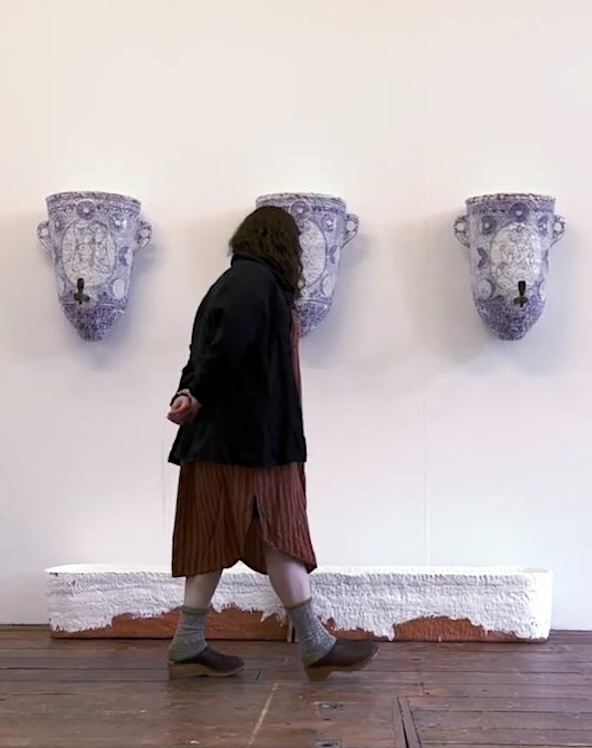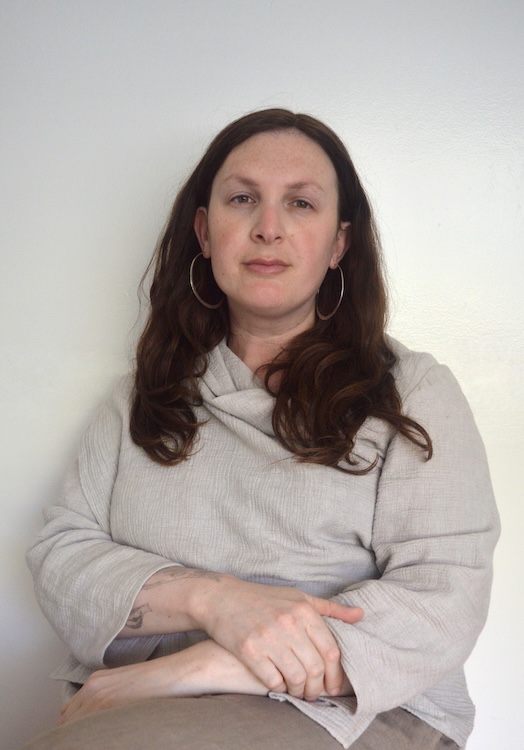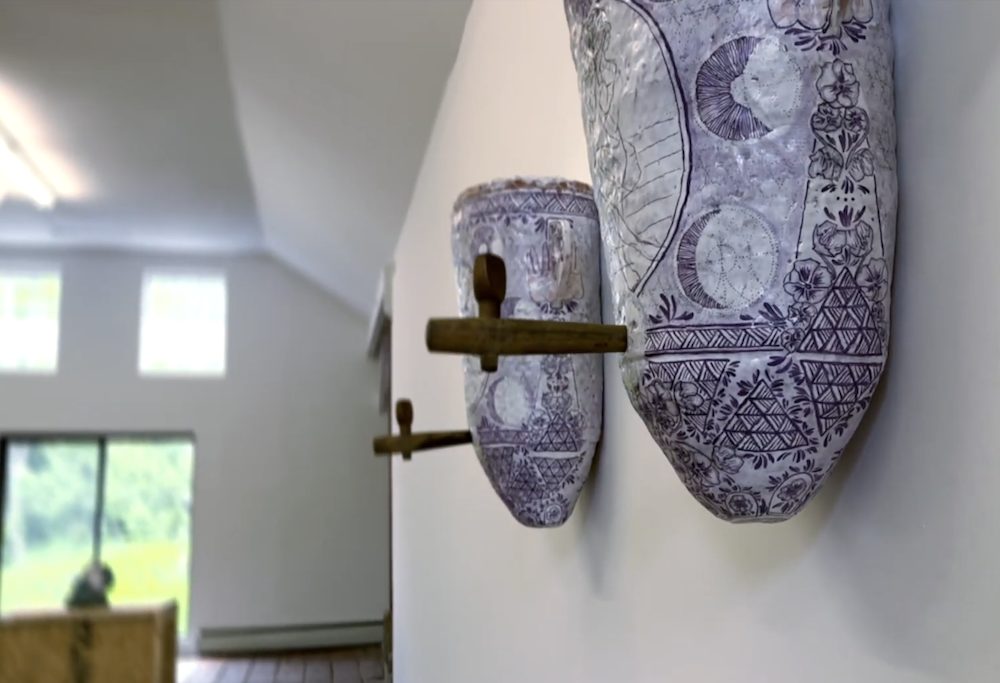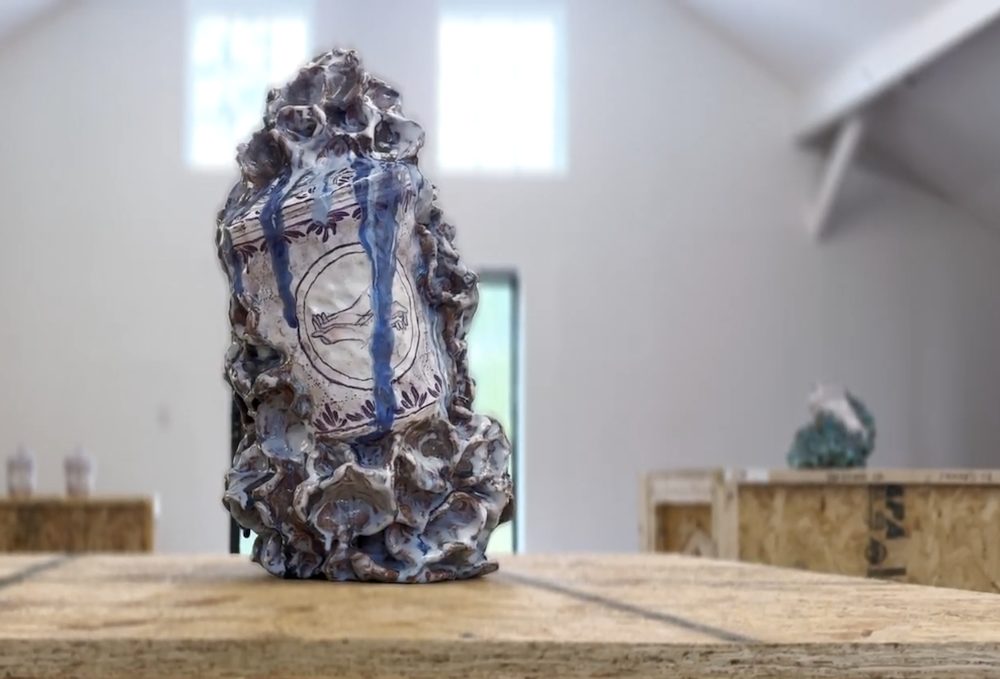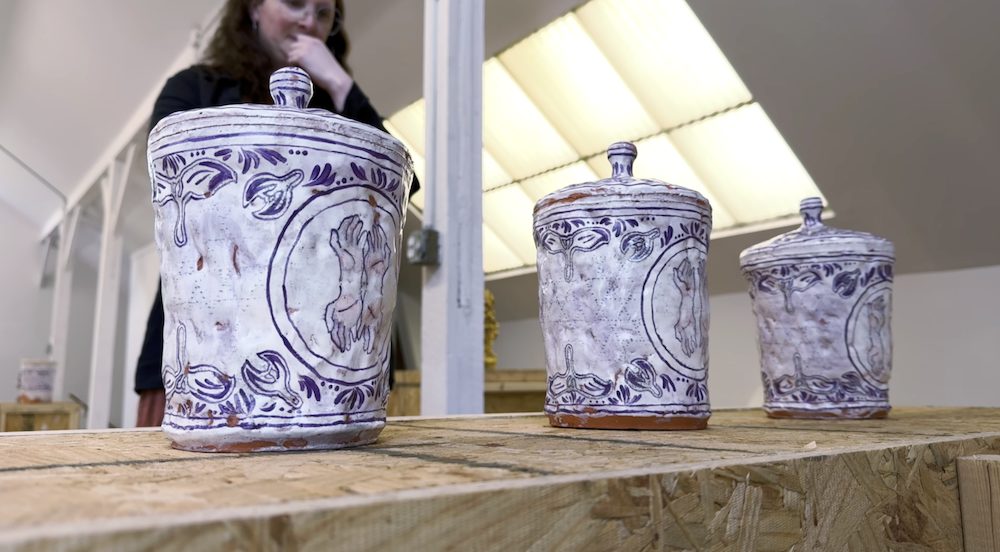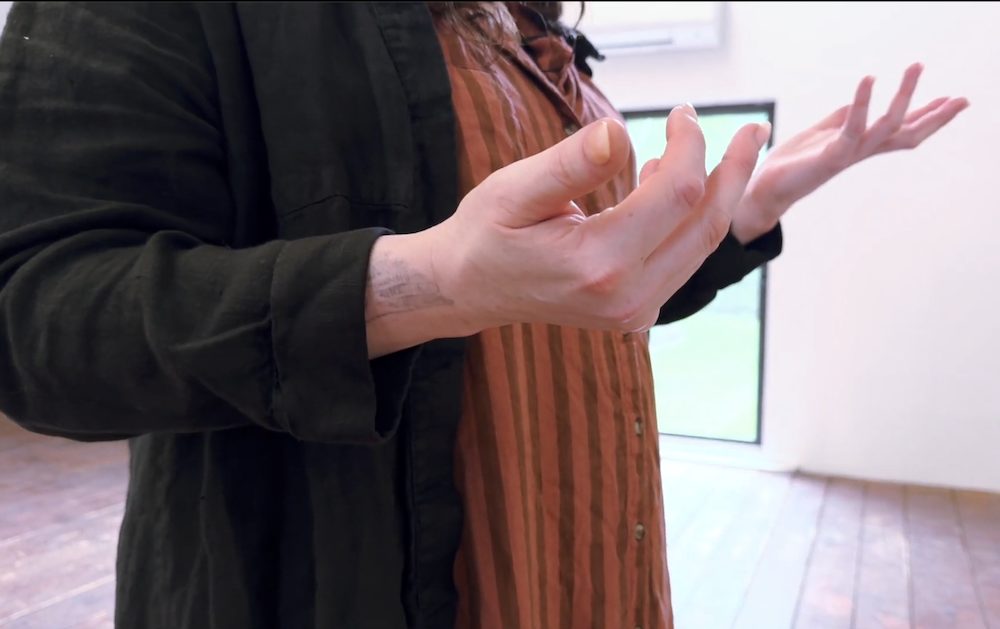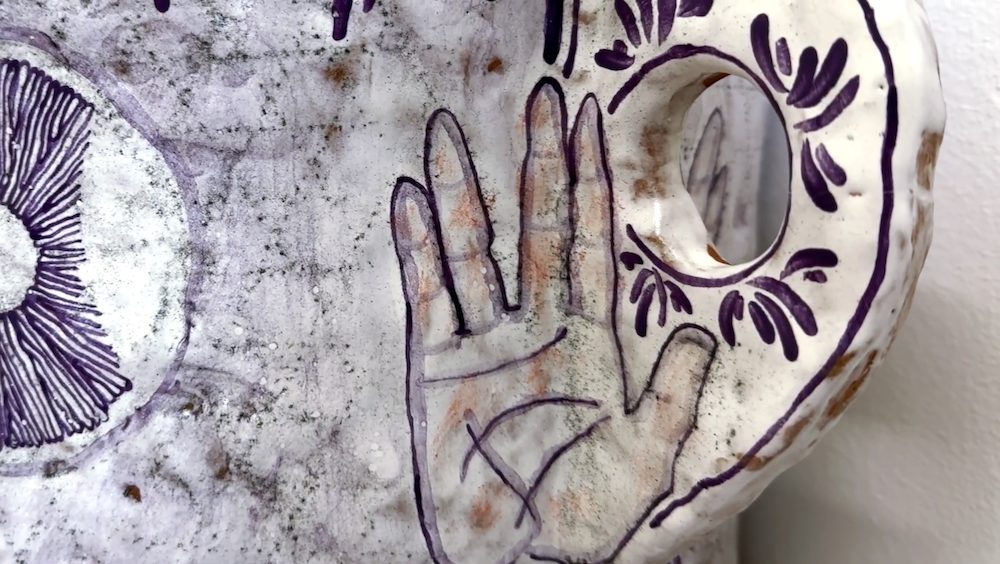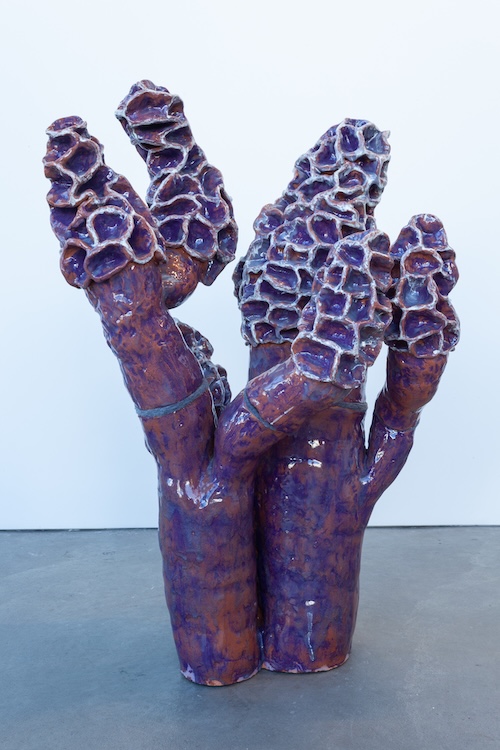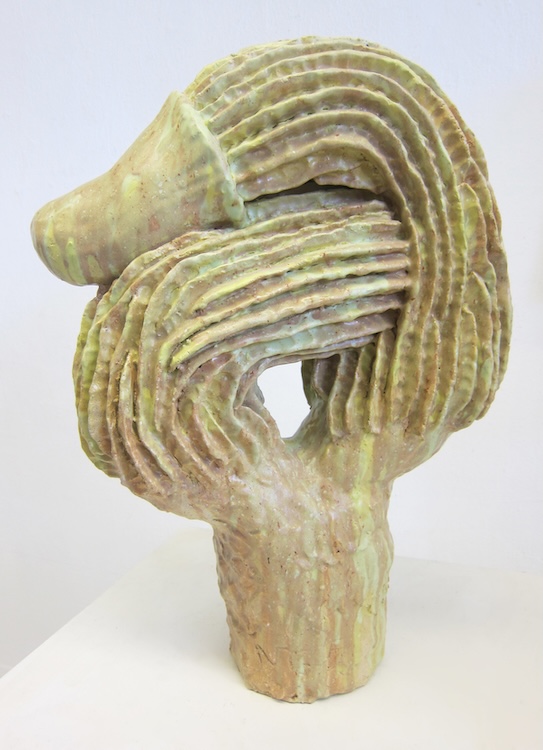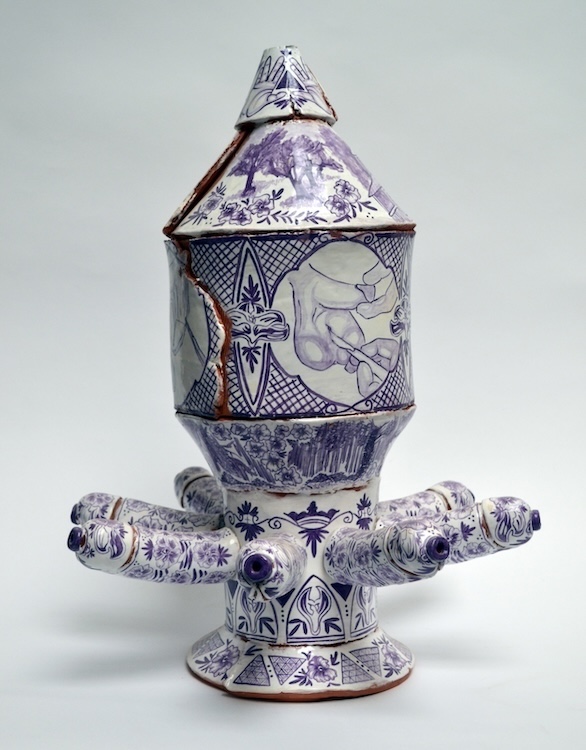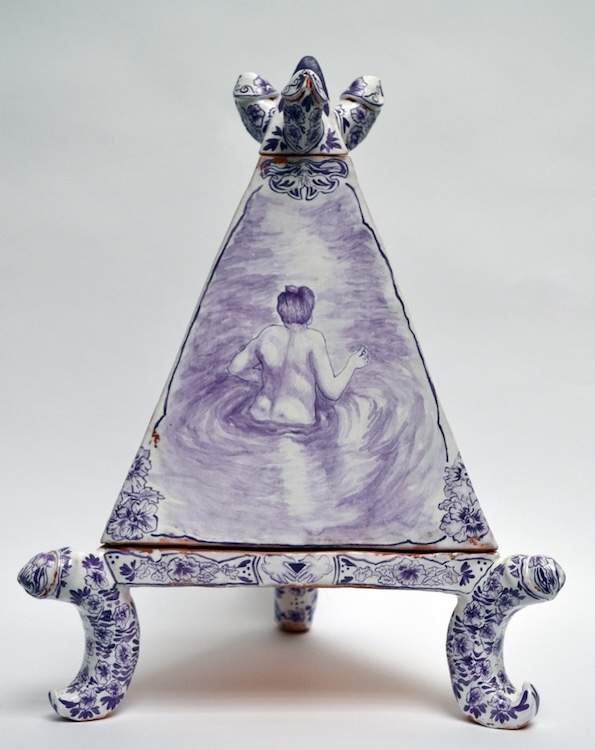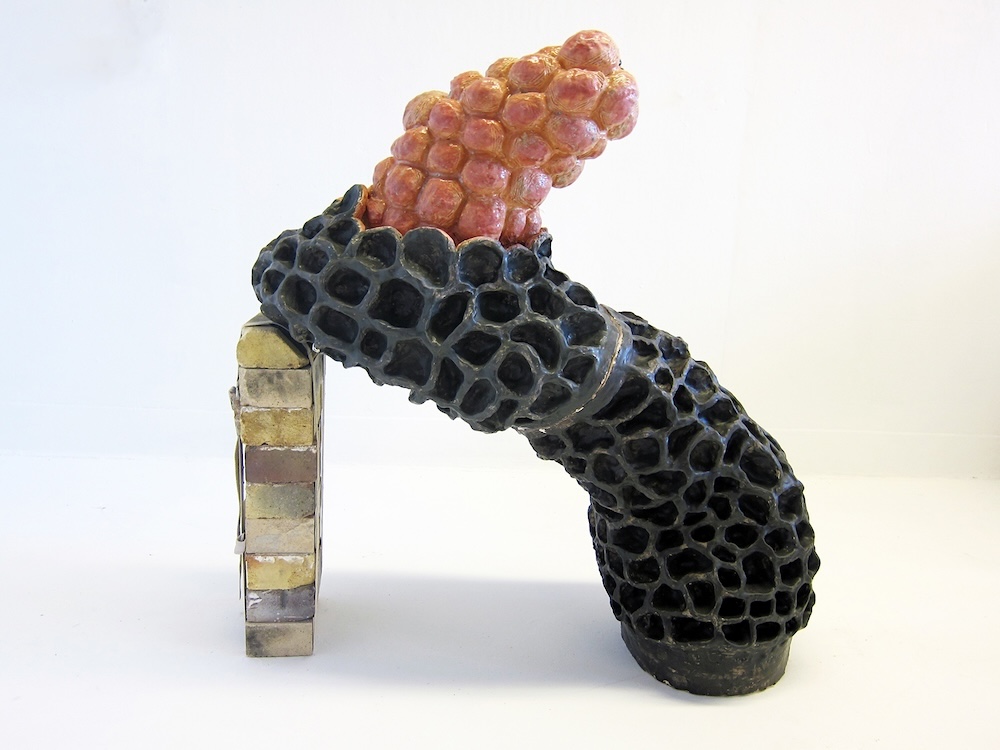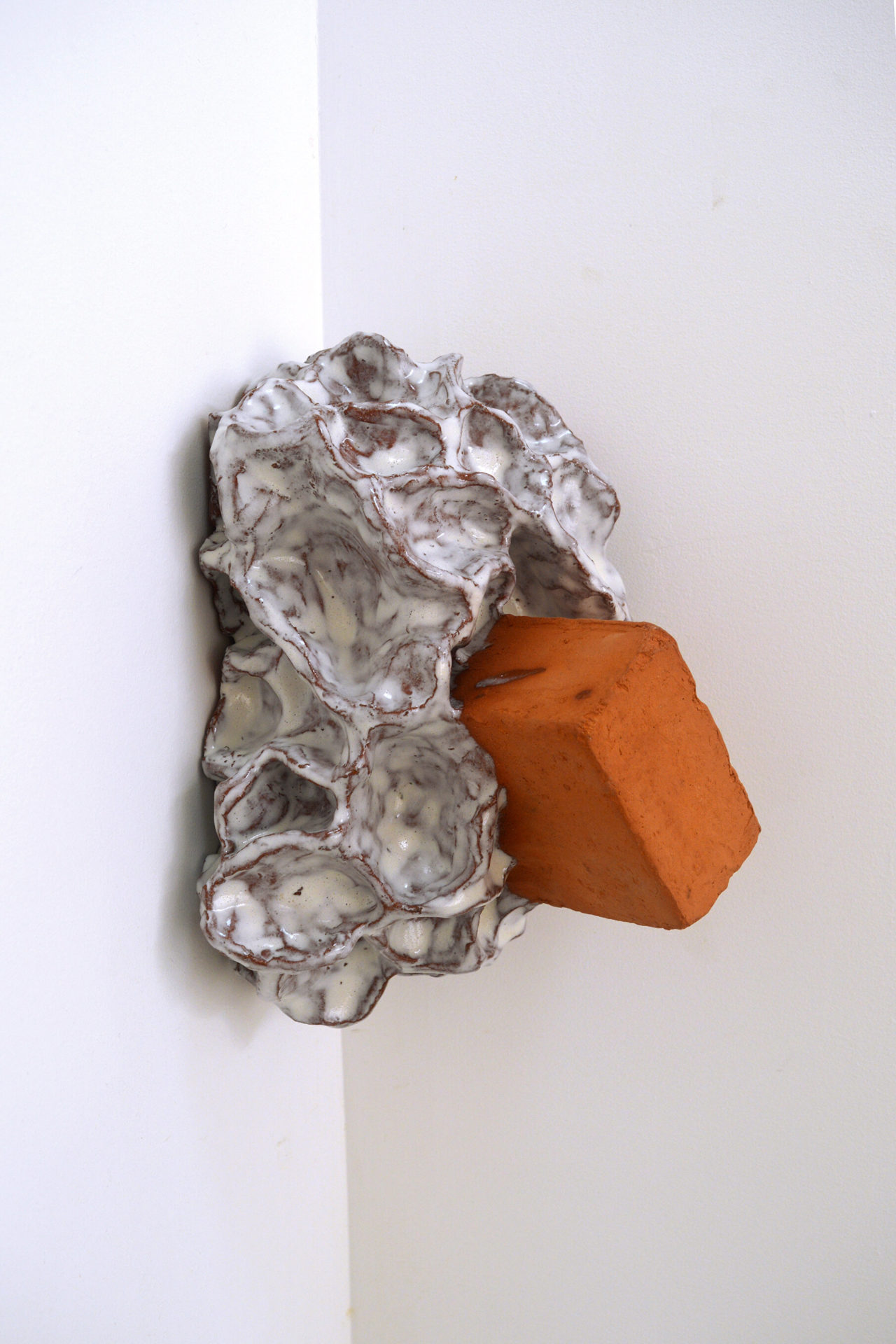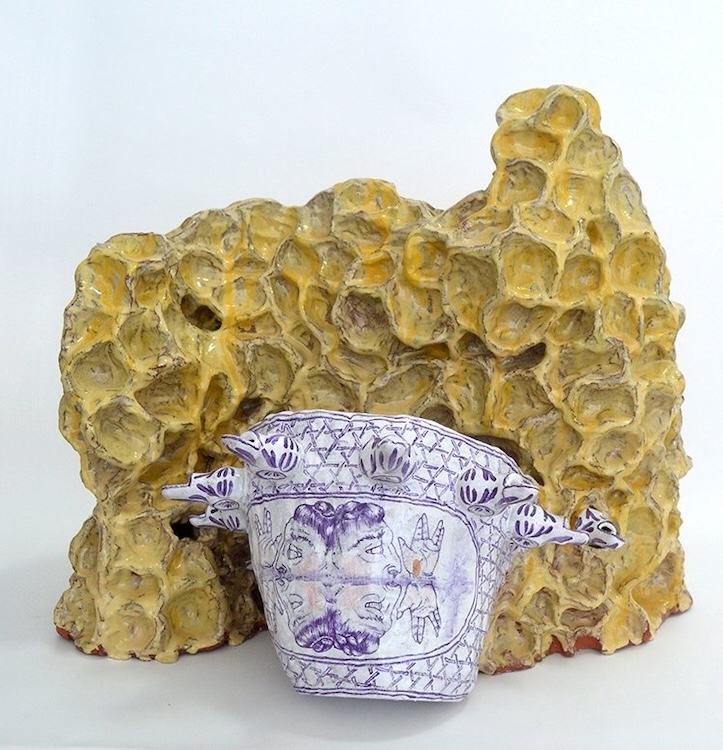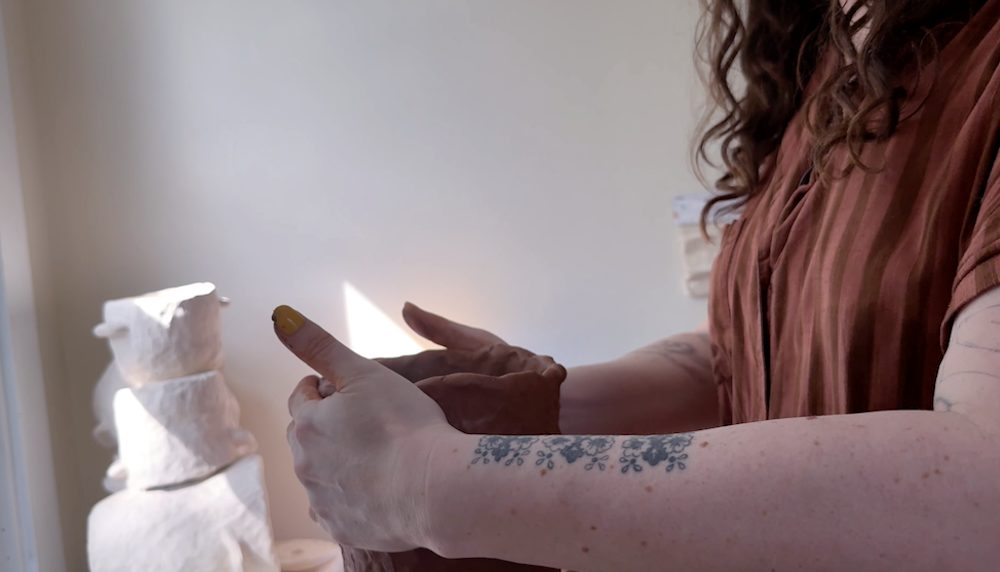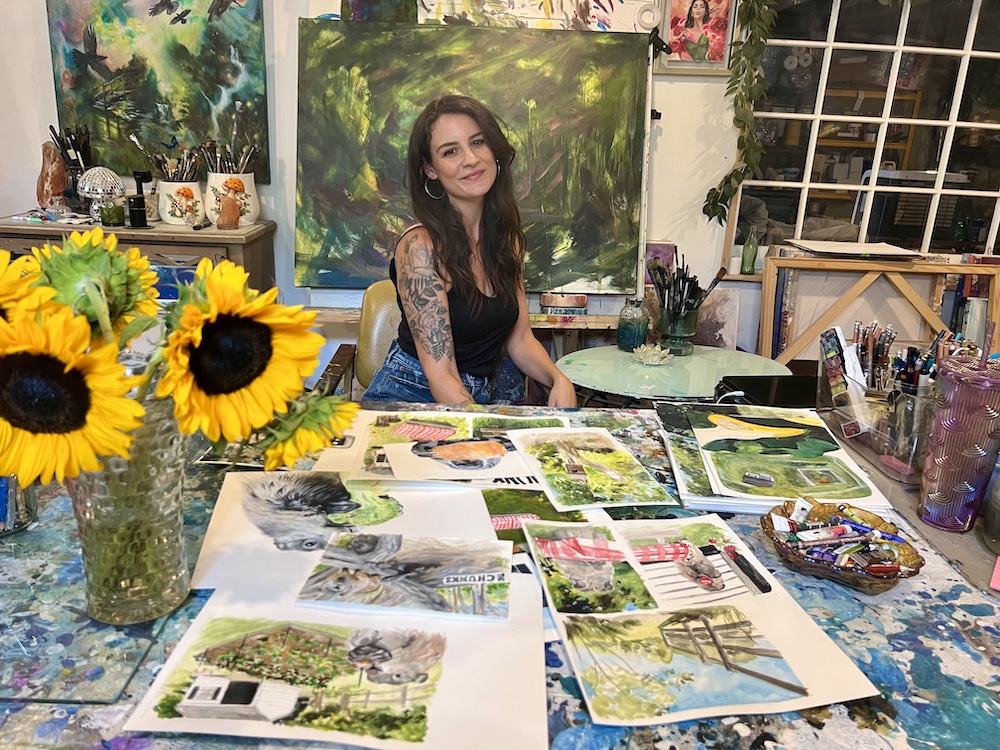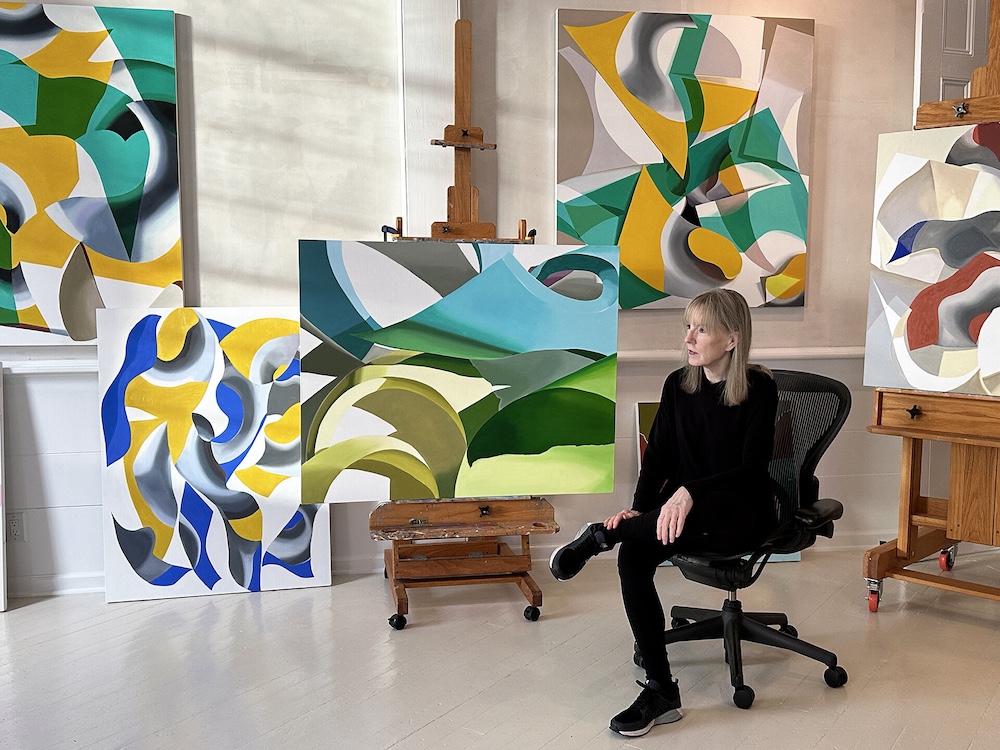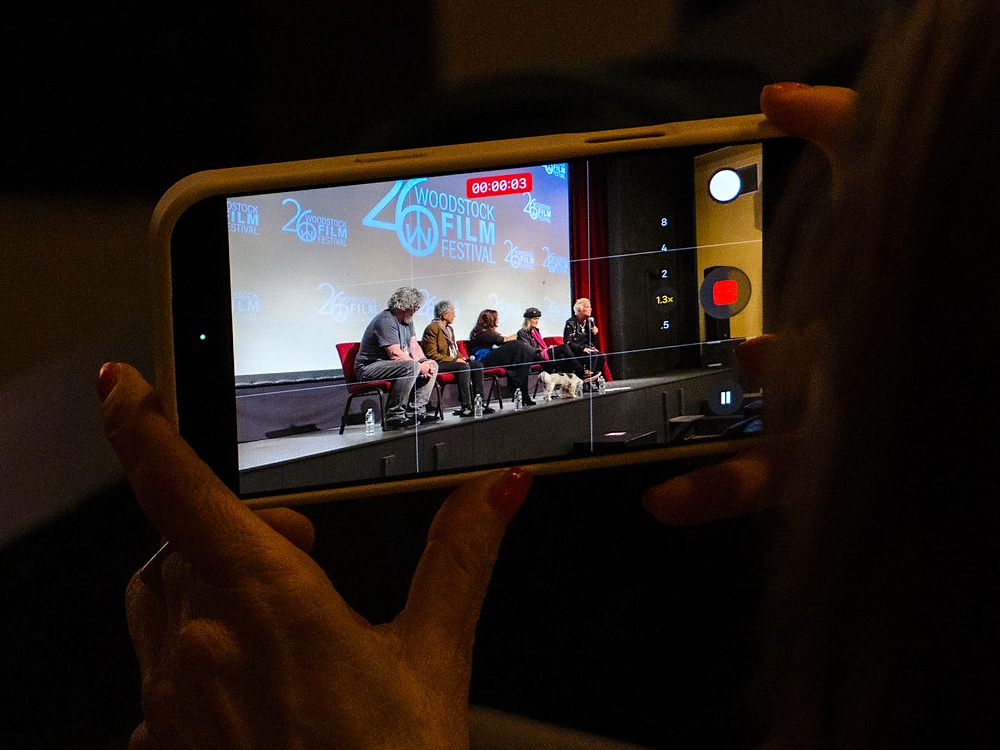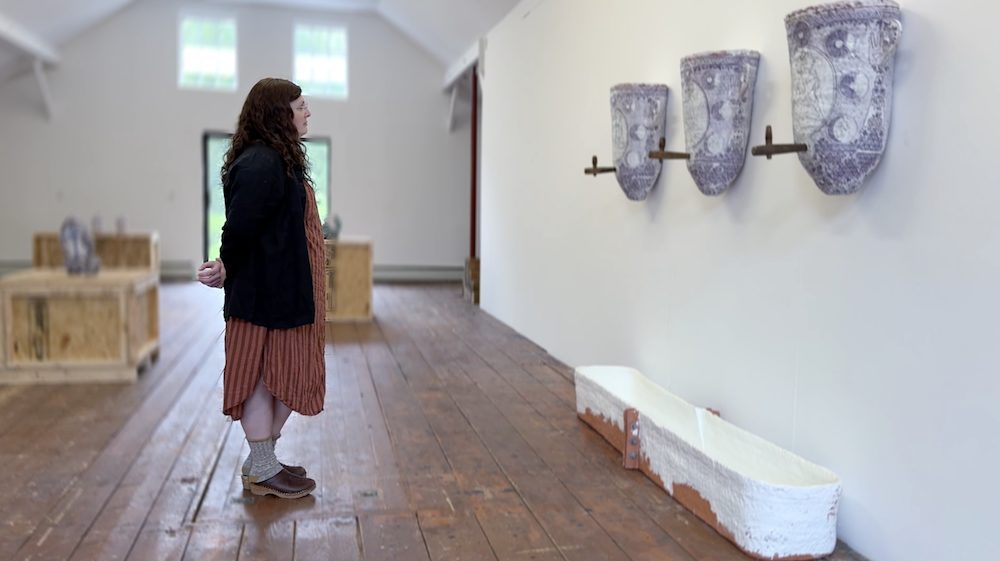
In the Studio with Hudson Valley Sculptor Nicki Green
Welcome to the next installment of “In the Studio with,” our ongoing series exploring the artists and their creative spaces throughout the Hudson Valley and Catskills region. Produced in collaboration with littlebitcreates, we spent time with sculptor Nicki Green, an interdisciplinary artist who works primarily in clay.
We visited Nicki this past summer at the Al Held Foundation, the location of her most recent solo exhibition presented in Al Held’s former drawing studio. The show included a multimedia installation using ceramic vessels and water, plus new works created for the space. It was curated by Liz Munsell, in partnership with River Valley Arts Collective and the Al Held Foundation. Nicki’s sculptures and other works explore the topics of history preservation, conceptual ornamentation and the aesthetics of otherness. Learn more about Nicki and her exciting work in our exclusive interview below.
INSIDE+OUT: Where are you originally from, and how did you wind up in the Hudson Valley?
Nicki Green: I was born in Boston, MA, and grew up just west of the city. I started my undergrad in psychology at The New School in New York City, but quickly realized I wanted to study art full-time. I transferred schools to study sculpture at the San Francisco Art Institute, and I really feel like I “grew up” or was socialized in the Bay Area. I went on to get an MFA in Art Practice at UC Berkeley, and continued to make work and teach in the Bay Area, and then later in Los Angeles. After 16 years in California, I got a tenure-track faculty position in the Division of Ceramic Art at Alfred University, New York State College of Ceramics in Western New York. I had always studied materials, including clay, conceptually first, so it has been an exciting shift to bring my teaching and studio practices to a hyper technical context (NYSCC began as a ceramic materials engineering school and maintains a material and technical rigor, even in the School of Art and Design.) Once in New York State, I started exploring the geography and had close artist friends who lived in the mid-Hudson region. I was so charmed by the area, and now I split my time between Alfred and Kingston.
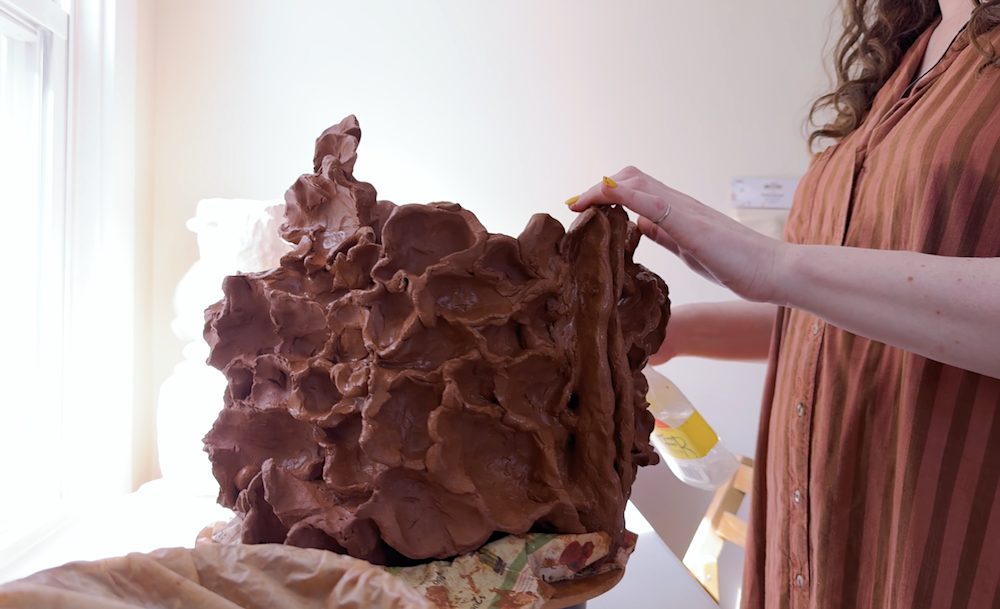
What inspired you to become a multi-disciplinary artist? What was your journey to clay?
Nicki Green: I’m not sure I was inspired to be multi-disciplinary as much as I just get fixated on and excited by many material practices and try to take them all seriously. I’ve always loved to play with art and craft supplies, some of my earliest memories were a preoccupation with materials like plaster bandage – I had these craft kits growing up, like a mask-making kit that I would refill the plaster bandage of over and over, or making friendship bracelets, polymer clay, beading, anything that was generative and fiddly. My aunt was an artist as well; she was an art teacher and would sit me at her kitchen table with crayons and really cultivate this appreciation of and significance towards making things. She helped me put together my transfer portfolio for undergrad and then passed away soon after I got into school and moved to the West Coast. Now, as a professor, I feel like I’m channeling her. I touched clay for the first time in high school. My parents sent me to The Cambridge School of Weston in Weston, MA, for the last two years of high school, and it changed my life. A space where I got to make art seriously for the first time. There were clay classes there, throwing and hand building, I was (still am!) so excited about the plasticity, “moldability” of the material. My first impression of it was excitement, the perplexity that it could mimic the aesthetic of other materials, and while I still appreciate the mimesis conceptually, I’m even more amazed at how loose and expansive this material is. Clay can really become anything.
Explain your exploration of material and object integrity through the lens of transness. How does this lens inform the way you view the world and your work?
Nicki Green: I’m excited, inspired by the ways bodies and our lives are absolutely always in transition, and that fluid shifting feels like a central idea I’m trying to explore, transness as a very broad set of experiences. Object-hood, especially ceramic objects, is so often thought of as stable, consistent, and permanent, but even fired ceramic objects are constantly changing, aging, and cracking. Nothing is as objective as we may want it to be, even if it’s just perception. Seeing form differently allows us to understand it differently and therefore shifts and transitions our understanding of that form.
You frequently incorporate images of hands in your work. What is the significance, and what excites you about hands?
Nicki Green: Hands are incredibly versatile tools; I might say some of the most transitional appendages human bodies have. I love the way that hands are both communicative (gesture, language, symbol) but also practical – they can do, become, mutate to serve so many functions. I also just love the look of long, wonky fingers. Haunting and elegant!
Your work is sculptural in nature, your vessels combining clay, fiber, and mushrooms. Can you share more about the materials and their relationship to form and function?
Nicki Green: I only recently began work with mushrooms as a material when I collaborated with artist Ashton S. Phillips, who casts objects from mycelium-reinforced soil. Before that, I only worked with mushrooms as a symbol, a metaphor. In terms of form, I am drawn to dimensional objects, sculptures, because they reflect the dimensions of our bodies. As I’ve begun making directly figurative sculpture (as distinct from functional or abstract forms), I’ve come to realize that even pots reference figures because function is inherently in relationship to the way a body comes into contact with the world around it. My colleague Linda Sikora often discusses pottery as an abstraction of function, and I also like to think about pottery as figurative, or maybe in relationship to a figure. So much of working with clay is about how the material receives or resists the maker’s contact with it, or how much the maker chooses to maintain or erase their contact with the material. I like fiber for a lot of reasons. I began sewing clothing and dolls for myself at a very early age, but now, there’s something very satisfying about the softness of fiber against the hardness of ceramic; they complement each other well.
What aesthetics motivate you in your work and in the world?
Nicki Green: Secondary colors like purples, peaches, teals- in between colors that have a sort of vibration-y softness, or the way that color contrast reinforces the presence of another color (the way white glaze feels so superficial and blanketing over the richness of terracotta clay, or the way navy and black against each other reveal just how different they are.) I love felt and wool, materials that have density. Clay becomes tight and vitreous as you fire it; quilted cloth also has a tightness or density. There was a period of time when I made quilts for vessels. I’m also totally preoccupied with cylindrical vessels lately- five, seven-gallon buckets, crocks, jars. Parallel-walled vessels are so satisfying.
Do you have upcoming shows that we should know about? Where can people find your work?
Nicki Green: I work a lot on the West Coast. After so many years working, showing, and teaching in California, I often travel back for shows and lectures. I just had a show at Human Resources LA, bricks that I made cross-country in collaboration with artist Ashton S. Phillips. After my solo at Al Held Foundation in Boiceville, NY, came down in the Summer of 2025, I’ve been working on a large cross-stitch piece for a show at The One Archives in Los Angeles in October 2025. I’m continuing to work on pieces for future shows as well, but nothing is firm enough to speak to specifics yet. Instagram is the most consistently updating place to find my work and programming, @nickigreenstudio, and I try to keep my website up to date.
What are the most challenging and the most rewarding aspects of being an artist?
Nicki Green: The hustle for sure. I’m constantly navigating the flow of resources, opportunities, the public and private-facing parts of my life and work. I’m sort of answering this as asking about being a professional artist because I’ve been so focused on the job of making art for the past 12 or so years. Making things, being creative is a lens, it’s how I process being in the world, professional or not. I’m not sure I could not engage creatively, but there was definitely a distinct period, (moment?) when I decided to start being visible with my practice and to work on developing a career as an artist. These feel like different modes or ways of engaging art making, but they’re for sure connected.
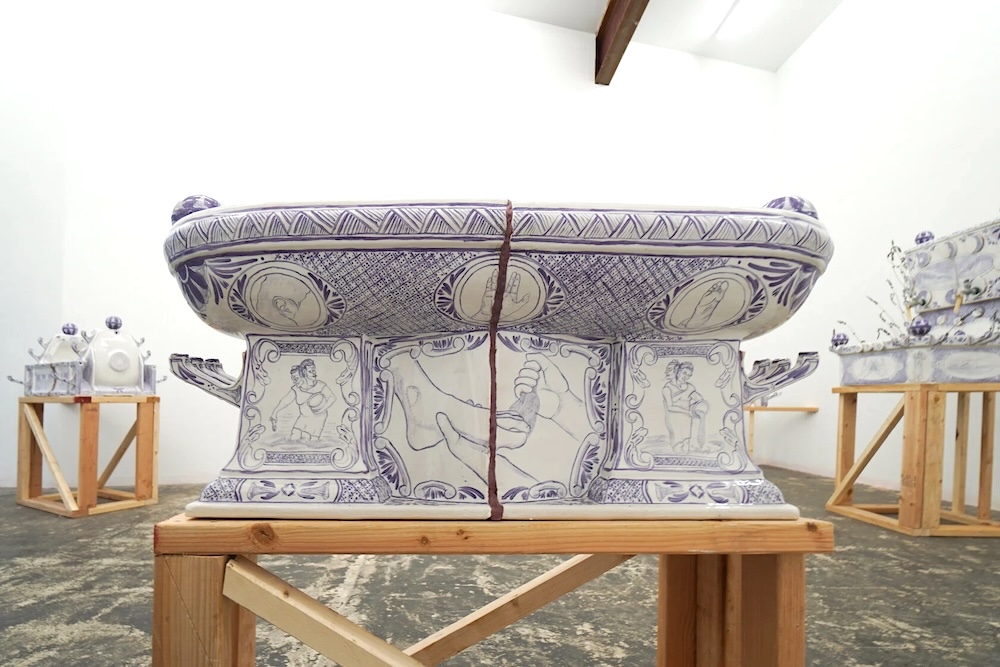
What is one question you’re constantly asked, or the biggest misconception about your art practice?
Nicki Green: People often ask me to interpret my work for them because I use pattern and illustration and sometimes recognizable symbols – I can appreciate that people want to know why I’m drawn to particular images, aesthetics, and that’s fair – I’m putting coded or symbolic forms into the world as a means of communicating, so I think the question I’m often being asked is really “What exactly are you saying?” But I think the issue is that I often make decisions aesthetically, formally. I’m way more interested in how the work appears or might be read or engaged with by others than if the origin or the instinct in making the work is legible.
What makes living in the Hudson Valley special for you?
Nicki Green: The Hudson River is this enormous force that splits the state! I love access to the woods with a tether to the city. It’s magical to live rurally and be urban-adjacent.
What impact does your practice have on your communities?
Nicki Green: I hope the impact is that the work makes something (fluidity, open, expansive engagement with the world?) feel possible… I’m really not sure, I would much rather ask folks from my communities what impact my work has on them… It’s not always entirely possible to know the impact, but I love to hear about it when people feel compelled to share!
What local businesses do you rely on to be successful?
Nicki Green: Bailey Ceramic Supply in Kingston is legendary!
Local Love: What other local business should we know about?
Nicki Green: Unicorn Bar in Kingston is amazing!
What is missing in the area that you wish we had?
More gay bars!
Who or what inspires you personally?
Nicki Green: Horror movies, drag, visible queerness, visible Jewishness. I’ve been deep diving into Hudson Valley Borscht Belt history these days. I drive through these towns between Alfred and Kingston and am so interested in insular religious communities. I’m also feeling very sweet on Susan Stryker’s work right now, and collaboration as a method, dialogue as a way of generating work.
What do you do for fun? What are some of your favorite ways to unwind and unplug when you are not in the studio?
Nicki Green: Watch RuPaul’s Drag Race.
What is your current state of mind?
Nicki Green: The world is such a mess; it’s so scary to be in the world right now. I’m constantly juggling numbing out and engaging deeply. Making work, studio time seems to be a way that those two modes can exist together.
Installation images by Alon Koppel
Exhibition and other photos courtesy of the artist
Follow/Connect with Nicki via Website | Instagram
+ + +
See more of our IN THE STUDIO WITH… Artist Series:
In the Studio with Artist Elizabeth Keithline
In the Studio with Bespoke Ceramicist R.A. Pesce
In the Studio with Experiential Artist Amanda Russo Rubman
In the Studio with Multimedia Artist David McIntyre
In the Studio With Artist Olaf Breuning: Laughter in the Dark
In the Studio with Contemporary Artist Andrew Lyght
In the Studio with Mixed Media Artist Yoko Izu
In the Studio with Abstract Artist Joel Longenecker
In the Studio with Horticulturist and Encaustic Artist Allyson Levy
In the Studio with Multidimensional Artist David Kucera
In the Studio with Contemporary Expressionist Ransome
+ + +
This ongoing artist series was produced in collaboration with Richard Hall and Mimi Young, founders of littlebitcreates.
Richard Hall and Mimi Young are the creative forces behind littlebitcreates. They produce a variety of projects, including in-depth artist profiles, event-specific promotional videos, and music videos. Their approach is exciting, innovative, and contemporary. In addition to their client work, Hall and Young collaborate with other creatives to create multidimensional, neo-surreal videos as part of a noncommercial venture. Littlebitcreates emerged from the extensive knowledge Hall and Young gained over 30 years of experience in photo shoots and multimedia art. They exclusively shoot all of their videos on iPhones, appreciating the distinctive aesthetic it produces and the comfort it offers their subjects in front of the camera.
Follow + Connect with littlebitcreates via Website | Vimeo | @littlebitcreates
Write a Comment
You must be logged in to post a comment.



